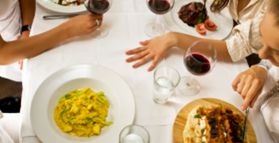 Eat with your eyes, and dont trust your gut feelings
Eat with your eyes, and dont trust your gut feelings
Posted on Mon, 23 Aug 10

Are your eyes bigger than your stomach? Apparently not. Relying on feeling full, as opposed to visual cues such as an empty plate, could cause you to overeat considerably.
Satiety signals produced in your digestive system after eating play an important role in controlling how much you eat. However, visual signals are also important. Experiments have shown that blindfolding people can result in them eating less than people who can see their meal but feel just as satisfied. And larger portions cause people to eat more with no difference in feelings of fullness or hunger than people who are served smaller portions.
Dinning in the dark
To determine just how important visual influences are for controlling your appetite a group of people were invited to a restaurant in Berlin, Germany where the dining area is pitch black and catered to by sight impaired waiters and waitresses. Half the group ate lunch in the well lit bar area while the other half ate in complete darkness.
People who ate in the dark consumed considerably more food while those who could see stopped eating sooner. Dinners in the dark also had difficulty estimating their calorie intake and were much more likely to eat dessert regardless of how much they had previously eaten.
Mindful eating
The study investigators concluded that the results of their “dining in the dark” experiment indicate that “non-visual cues do not provide as accurate input as visual cues for estimating food quantities and satiety and thus for stopping consumption. Without easy access to visual cues, for example during a typical dinner in front of the TV where the light is dim, people may readily misestimate what they are eating.”
There are several ways you can change your visual food environment to mindlessly eat less including; reducing your serving sizes and consumption by using smaller bowls and plates, repackaging foods into smaller containers, and reducing the visibility of stored foods by moving them to a cupboard. Out of sight is out of mind.
Reference:
Scheibehenne B, Todd PM, Wansink B. Dining in the Dark: The Importance of Visual Cues for Food Consumption and Satiety. Appetite. 2010 Aug 12. [Epub ahead of print]
Tags: Mindful Eating, Mindless Eating, Portion Size




